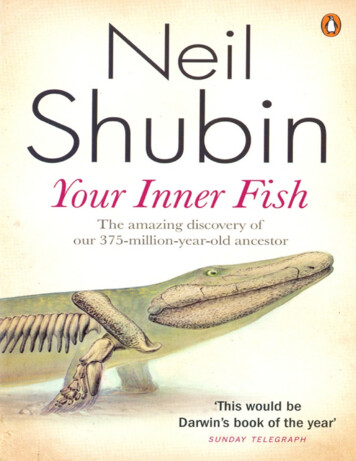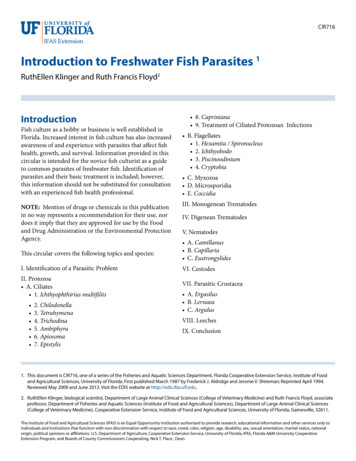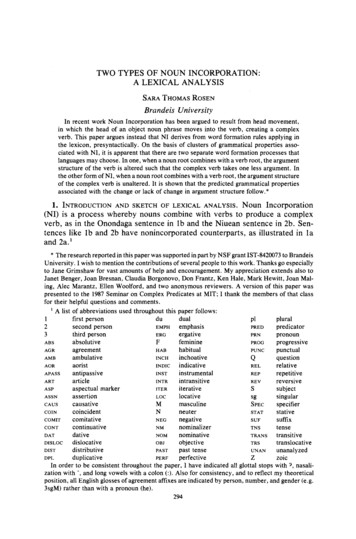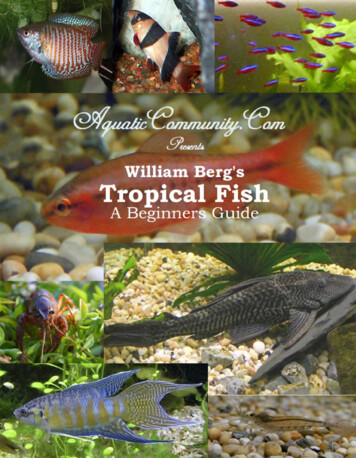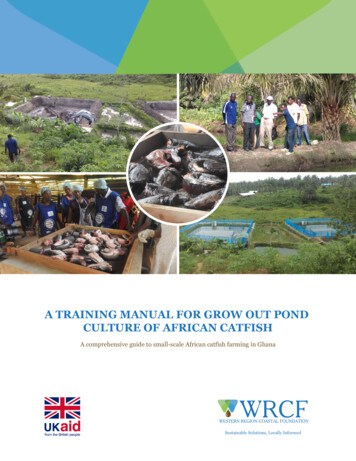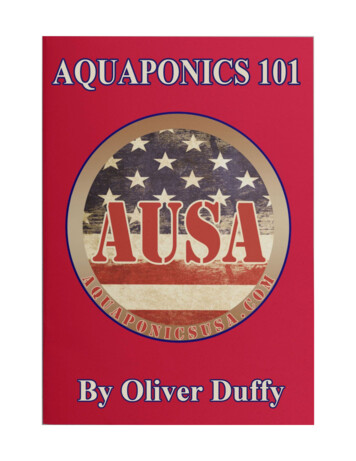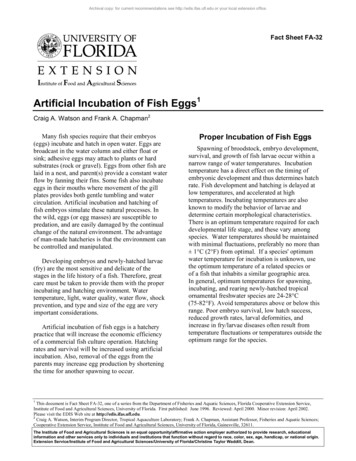
Transcription
Archival copy: for current recommendations see http://edis.ifas.ufl.edu or your local extension office.Fact Sheet FA-32Artificial Incubation of Fish Eggs1Craig A. Watson and Frank A. Chapman2Many fish species require that their embryos(eggs) incubate and hatch in open water. Eggs arebroadcast in the water column and either float orsink; adhesive eggs may attach to plants or hardsubstrates (rock or gravel). Eggs from other fish arelaid in a nest, and parent(s) provide a constant waterflow by fanning their fins. Some fish also incubateeggs in their mouths where movement of the gillplates provides both gentle tumbling and watercirculation. Artificial incubation and hatching offish embryos simulate these natural processes. Inthe wild, eggs (or egg masses) are susceptible topredation, and are easily damaged by the continualchange of the natural environment. The advantageof man-made hatcheries is that the environment canbe controlled and manipulated.Developing embryos and newly-hatched larvae(fry) are the most sensitive and delicate of thestages in the life history of a fish. Therefore, greatcare must be taken to provide them with the properincubating and hatching environment. Watertemperature, light, water quality, water flow, shockprevention, and type and size of the egg are veryimportant considerations.Artificial incubation of fish eggs is a hatcherypractice that will increase the economic efficiencyof a commercial fish culture operation. Hatchingrates and survival will be increased using artificialincubation. Also, removal of the eggs from theparents may increase egg production by shorteningthe time for another spawning to occur.Proper Incubation of Fish EggsSpawning of broodstock, embryo development,survival, and growth of fish larvae occur within anarrow range of water temperatures. Incubationtemperature has a direct effect on the timing ofembryonic development and thus determines hatchrate. Fish development and hatching is delayed atlow temperatures, and accelerated at hightemperatures. Incubating temperatures are alsoknown to modify the behavior of larvae anddetermine certain morphological characteristics.There is an optimum temperature required for eachdevelopmental life stage, and these vary amongspecies. Water temperatures should be maintainedwith minimal fluctuations, preferably no more than 1 C (2 F) from optimal. If a species' optimumwater temperature for incubation is unknown, usethe optimum temperature of a related species orof a fish that inhabits a similar geographic area.In general, optimum temperatures for spawning,incubating, and rearing newly-hatched tropicalornamental freshwater species are 24-28 C(75-82 F). Avoid temperatures above or below thisrange. Poor embryo survival, low hatch success,reduced growth rates, larval deformities, andincrease in fry/larvae diseases often result fromtemperature fluctuations or temperatures outside theoptimum range for the species.1This document is Fact Sheet FA-32, one of a series from the Department of Fisheries and Aquatic Sciences, Florida Cooperative Extension Service,Institute of Food and Agricultural Sciences, University of Florida. First published: June 1996. Reviewed: April 2000. Minor revision: April 2002.Please visit the EDIS Web site at http://edis.ifas.ufl.edu.2Craig A. Watson, Interim Program Director, Tropical Aquaculture Laboratory; Frank A. Chapman, Assistant Professor, Fisheries and Aquatic Sciences;Cooperative Extension Service, Institute of Food and Agricultural Sciences, University of Florida, Gainesville, 32611.The Institute of Food and Agricultural Sciences is an equal opportunity/affirmative action employer authorized to provide research, educationalinformation and other services only to individuals and institutions that function without regard to race, color, sex, age, handicap, or national origin.Extension Service/Institute of Food and Agricultural Sciences/University of Florida/Christine Taylor Waddill, Dean.
Archival copy: for current recommendations see http://edis.ifas.ufl.edu or your local extension office.Artificial Incubation of Fish Eggs2The amount and incidence of light receivedduring incubation can affect both fish developmentand larval survival. Incubation of fish embryosshould occur in either dim light or darkness. Lightcan also be used to synchronize hatching. Manyspecies of fish will not hatch in daylight, therefore,if the lights are switched off, hatching will occur afew hours later.Egg diameter is also an important considerationduring incubation. Screen mesh size should preventthe passage of eggs while allowing sufficient watercirculation and detering debris collection. Mostornamental fish eggs are around 0.8 mm indiameter, however, the size range is wide. Eggs canbe as large as 1.5-2.0 mm for some ornamentalcatfish, and as small as 0.4 mm for gobies.Because of their size and permeability, fishembryos and larvae are susceptible to many types oforganic or inorganic materials dissolved orsuspended in the water. These may include gases,minerals, metals, and particulate matter from rocks,soil, plants and animals. It is essential to know thewater quality standards for embryos and larvae ofthe particular fish species. General water qualitystandards used in fish culture can be used as areference point for hatchery water. These standardsare available in aquaculture textbooks or from theFlorida Cooperative Extension Service.Types of Fish Egg IncubatorsDuring incubation, a constant water flow isessential for preventing accumulation of wasteproducts and allowing gas exchange between theegg and the surrounding water. Constant motionalso appears to be necessary for successful hatchingfor some species of fish. Proper water flow alsoreduces mechanical abrasion. Eggs of many fish aresensitive to mechanical shock and should not bemoved during certain times during development.For example, eggs of salmon and trout can only bemoved during the first 36 hours after fertilization.Thereafter, the eggs are kept still until the embryoeye becomes visible. The amount of water flownecessary for proper incubation of fish embryosdepends largely on egg density (how heavy andlarge eggs are in water). Some fish eggs are quitedense and sink to the bottom when released. Othereggs become buoyant as they "water-harden" andfree-float in the water column or at the surface.Some eggs have hair-like structures or specializedcoatings that make them sticky. Some eggs have anoil drop in them and they float on the surface.A wide variety of devices are used forincubating fish eggs. For practical purposes, wehave classified fish egg incubators into three majortypes: egg mats, trays, and conical incubators. Theiruse is based primarily on the density of the eggs tobe hatched, their stickiness, and the sensitivity ofthe eggs to mechanical shock. Figure 1, Figure 2,and Figure 3 illustrate the three general types of fishegg incubators.Egg mats are used primarily for adhesive eggs.By simulating a spawning substrate (plants, rocks,etc.), they serve as egg collectors and provide aplace for egg attachment. Since egg mats also serveas a stimulus for spawning, they are also known asspawning mats. Mats consist of bundles of fibrousmaterial arranged in a variety of forms and madefrom a variety of different materials (plastic shreds,air filters, spanish moss, coconut fibers, horse hairs,etc.) (Figure l, a and b). Typically, egg mats aresuspended in the water column or laid along thebottom or sides of the spawning container. Themats can be removed from the spawning containerand suspended in the air where they can be keptmoist at all times with a fme spray of water. Theoxygen content of air is about 20 times more thanwater, thus increasing gas exchange between theegg and the thin film of water that surrounds them.For spawning and incubating eggs of manyornamental fish, such as angelfish, discus, andcorydoras catfish, mats are often replaced withbottle brushes, pots, or slates that are made ofplastic, glass, clay or rock (Figure 1c).
Archival copy: for current recommendations see http://edis.ifas.ufl.edu or your local extension office.Artificial Incubation of Fish EggsFigure 1. Egg mats: frameworks with a) spanish moss and b) bundled fibers; c) slate, claypot and bottle brush.Figure 2. Incubators: a) traditional “happa” framework with fine mesh, b) basket-type, and c) multiple baskets withpaddlewheels.Figure 3. Incubators for non-adhesive eggs: All three devices provide gentle water circulation.3
Archival copy: for current recommendations see http://edis.ifas.ufl.edu or your local extension office.Artificial Incubation of Fish EggsA tray-type incubator consists of a container thatis screened or perforated, through which a flow ofwater permeates to supply the eggs with oxygen andflush away waste products (Figure 2). They areoften designed so that water penetrates the trayfrom below and flows out over the upper edge.Since the eggs lay over a screen, tray-typeincubators are ideal for fish eggs that can be injuredby movement during incubation. Tray incubatorscan be stacked and provide easy access for removalof dead embryos. The newly-hatched larvae candrop through the screen holes minimizing handlingand removal of the egg shells.Tray-type incubators were originally designed tohatch trout and salmon eggs. The eggs of salmonidfish are large, non-adhesive and laid in a gravel bedduring natural spawning. The eggs must remain stilland in the dark since abrupt movements and directsunlight affect embryonic development.Tray-type incubators also are formed intobaskets and commonly used to incubate and hatchchannel catfish eggs. The baskets are placed in awater trough, and paddlewheels, which are attachedto the trough, provide aeration and gentlecirculation of the water. Baskets can also be placedoutside the spawning tank and then used asincubators. The "hapa" or net enclosurestraditionally used for spawning, egg incubation, andlarval rearing of common carp function sirnilarly tobasket or tray incubators.Fish eggs that are non-adhesive and requireconstant movement are commonly incubated inconical shaped tanks or jars where water flows intothe bottom or top of the container (Figure 3). In thistype of incubator the eggs are gently suspended andconstantly tumble in the lower portion of the jar.The flowing water not only insures that goodquality, well oxygenated water is constantly beingreplaced in the jar, but the tumbling of the eggskeeps them from collecting debris which can lead tofungal infections. These types of incubators can beset in series above a rearing tank. The larvae pourout of the incubators into the rearing tank as theyhatch. A soft meshed material can be shaped into acone and used as an incubator. It is advantageous touse screen because greater surface area is providedfor water to flow out, preventing the eggs, yolk-saclarvae or the larvae from becoming crushed.4Incubators made of net material require structuralsupport and must be suspended inside a larger tankor placed into the rearing tank.Setting the Flow Rate in UpflowWater IncubatorsWhen first introduced to water, free-floating fisheggs will almost always swell in size as they absorbwater, and usually become more buoyant. It istherefore critical to make adjustments to the waterflow as needed during the first hour or so.Once the flow has been set to keep the eggs insuspension, it is important to maintain that leveluntil the eggs hatch. Depending on the species, thiscould be hours or days. Supplying constant pressureand volume of water is crucial. Do not use a pumpor delivery system incapable of supplying constantpressure and volume of water to the jars.A good way to insure that the volume and flowremain constant is by using a header system. Alarge diameter PVC pipe (minimum of twice thediameter of the pipe coming from the pump) iselevated above the incubators. An open-endedelbow is placed on the opposite end of the pipe toallow surplus water to exit (either as effluent in aflow-through or back to the sump in a waterrecirculating system). The supply lines for the jarsare tapped into the large diameter "header" pipe, atequal elevations, thus supplying all jars with anequal beginning pressure. Each supply line has itsown valve to control the flow to the individual jars,since the amount of eggs in each jar will not be thesame. Even with a good header or other flowcontrol system, the buoyancy of eggs will changeover time. Periodically check to make sure that theeggs are tumbling properly.Hatching jars should be placed so the overflowgoes into the tanks where the fry will be reared.This eliminates the need for handling the fry. Somefry will swim with the current after hatch, whileothers will swim against the current. For the lattergroup, gently pour them out of the incubators,instead of increasing the water flow.If working with an extremely large quantity ofeggs, you may want to design a hatching tank. Thetank should have a conical bottom and be made
Archival copy: for current recommendations see http://edis.ifas.ufl.edu or your local extension office.Artificial Incubation of Fish Eggsfrom a smooth surfaced material (rough concretewill damage many eggs). Again, stick with theprincipals; provide water temperature control andgood water quality, dim lights, avoid mechanicalshock and if necessary, gently tumble the eggs inthe water column; do this and you will not gowrong.Incubation and Hatching Systemsare Simple to MakeNumerous types of fish egg incubators can bepurchased commercially ready-to-use. They arecommonly designed to hold thousands or evenmillions of eggs. They are also relatively expensive.Each unit may cost from 85–250. Because mostornamental fish do not lay large numbers of eggs(e.g., compared to striped bass or grass carp), and tosave space and money, ornamental fish farmers canmake their own incubators. The references belowprovide general descriptions and operatingprocedures of two water incubators that can beeasily built using commonly available materials.The first design has been used successfully inhatching many different types of fish eggs,including the red-tail black, and rainbow sharks(Labeo spp.). The second design provides an optionto incubate eggs of cichlid fish. Both incubators areextremely simple and inexpensive to make.SummaryIncubation and hatching containers areextremely cost effective given the increase inhatching and survival rates which can be achieved.Artificial incubation of eggs is also necessary whenspawning certain types of fish. The design of anincubator and water flow adjustments will dependon the species, egg density, adhesiveness, andsusceptibility to mechanical shock. A biologicalknowledge of the species requirements is essential,however, the technical principles are simple: supplygood quality water at a constant temperature,incubate in low light, and prevent mechanicaldamage to the eggs by providing gentle water flowover the eggs. Depending on your needs, you canutilize a system of several small incubators attachedto a common supply line or a few large rearingtanks. Commercially manufactured incubators areavailable, but making your own can often save youwater, space, and money.5ReferencesBrooks, G.B. 1994. A simplified method for thecontrolled production and artificial incubation ofOrechromis eggs and fry. The Progressive FishCulturist 56:58-59.Rottmann, R. and J.V. Shireman. 1988.Hatching Jar that is inexpensive and simple toassemble. The Progressive Fish-Culturist 50:57-58.
Fact Sheet FA-32 . Artificial Incubation of Fish Eggs. 1. Craig A. Watson and Frank A. Chapman. 2 1 This document is Fact Sheet FA-32, one of a series from the Department of Fisheries and Aquatic Sciences, Florida Cooperative Extension Service, . Institute of Food and Agricultural Sciences, University of Florida.
